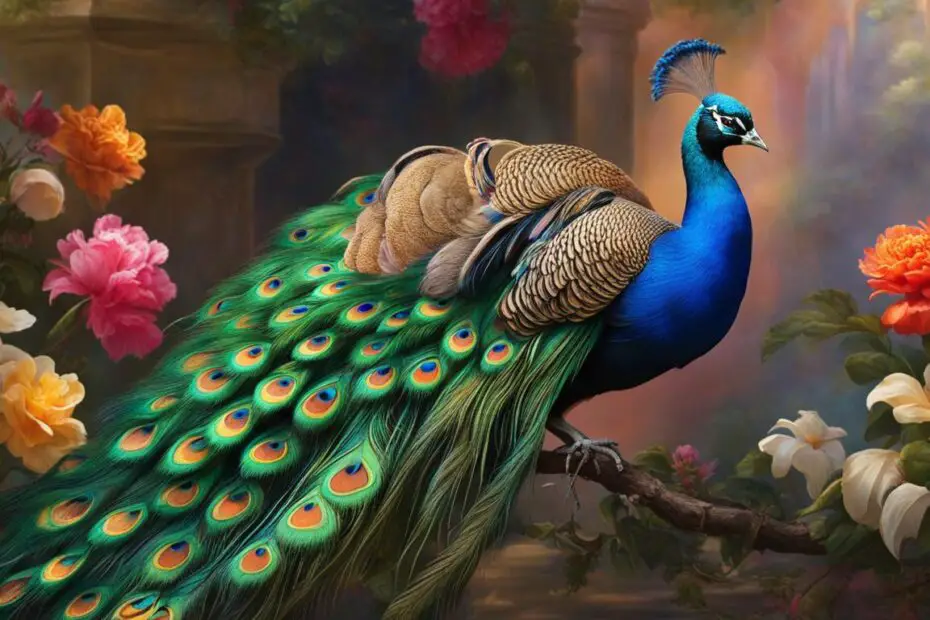Welcome to the captivating world of peacocks and chickens, two mesmerizing species of birds that have enthralled bird enthusiasts and nature lovers for centuries. With their unique behaviors, stunning plumage, and diverse breeds, peacocks and chickens are truly exotic creatures that continue to captivate our imagination.
Peacocks, a species of peafowl, are renowned for their ornamental blue and green tail feathers. These magnificent birds are often associated with beauty and grace, and their displays during mating season are a sight to behold. In contrast, chickens, commonly raised as poultry birds, have a more humble yet endearing appeal. They are popular in backyard farming and play a vital role in sustainable food production.
In this article, we will delve into the world of these fascinating birds, exploring their various breeds, lifecycles, care requirements, unique characteristics, cultural significance, historical uses, and conservation efforts. So let’s embark on this journey and unlock the secrets of peacocks and chickens together.
Key Takeaways:
- Peacocks and chickens are exotic birds that captivate bird enthusiasts.
- Peacocks are known for their ornamental tail feathers, while chickens are popular in backyard farming.
- Peacocks come in different breeds, each with unique characteristics and color variations.
- Chickens have specific care requirements and are bred in various breeds for different purposes.
- Understanding the behavior and needs of peacocks and chickens contributes to their conservation and habitat protection.
The Beauty of Peacocks and Their Breeds
Peacocks, with their vibrant and ornate plumage, are truly a sight to behold. These majestic birds come in various breeds, each with its own unique characteristics and color variations. Let’s explore some of the most well-known breeds of peacocks:
Indian Blue
The Indian Blue peacock is perhaps the most recognizable and iconic breed. It is known for its stunningly colorful plumage, featuring iridescent blues and greens. The male Indian Blue peacock has a long and elaborate train of feathers that it displays during courtship rituals, mesmerizing both onlookers and potential mates.
Java Green
The Java Green peacock is a rarer breed and is considered an endangered species. Its plumage boasts rich shades of green, with intricate patterns and markings. The Java Green peacock is known for its elegance and grace, making it a prized and sought-after breed among bird enthusiasts.
Congo Peafowl
The Congo Peafowl is smaller in size compared to the Indian Blue and Java Green peacocks. It features a more subdued color palette, with shades of dark blue and green. Resembling pheasants, the Congo Peafowl has a unique charm and beauty that sets it apart from other peacock breeds.
Each of these peacock breeds showcases the breathtaking beauty that peacocks are known for. Their distinctive plumage and vibrant colors make them a favorite among bird enthusiasts and lovers of exotic birds.
| Breed | Appearance | Size |
|---|---|---|
| Indian Blue | Iridescent blues and greens | Large |
| Java Green | Rich shades of green, intricate patterns | Large |
| Congo Peafowl | Shades of dark blue and green | Medium |
The Lifecycle of Peacocks
Peacocks go through different stages in their lifecycle. Understanding these stages can provide valuable insights into their mating behaviors, feather development, and overall growth. Let’s explore the fascinating journey of a peacock’s lifecycle.
Mating Season
The breeding season for peacocks typically occurs from April to August. During this time, the male peacock uses its train feathers in a beautiful display to attract females. The train feathers, also known as the “train,” are long, ornamental feathers that form a mesmerizing fan-like shape when spread open.
These feathers are brilliantly colored with iridescent shades of blue, green, and sometimes even gold. The male peacock will strut and shake its train feathers to create a stunning visual display, accompanied by calls to court the female peahens.
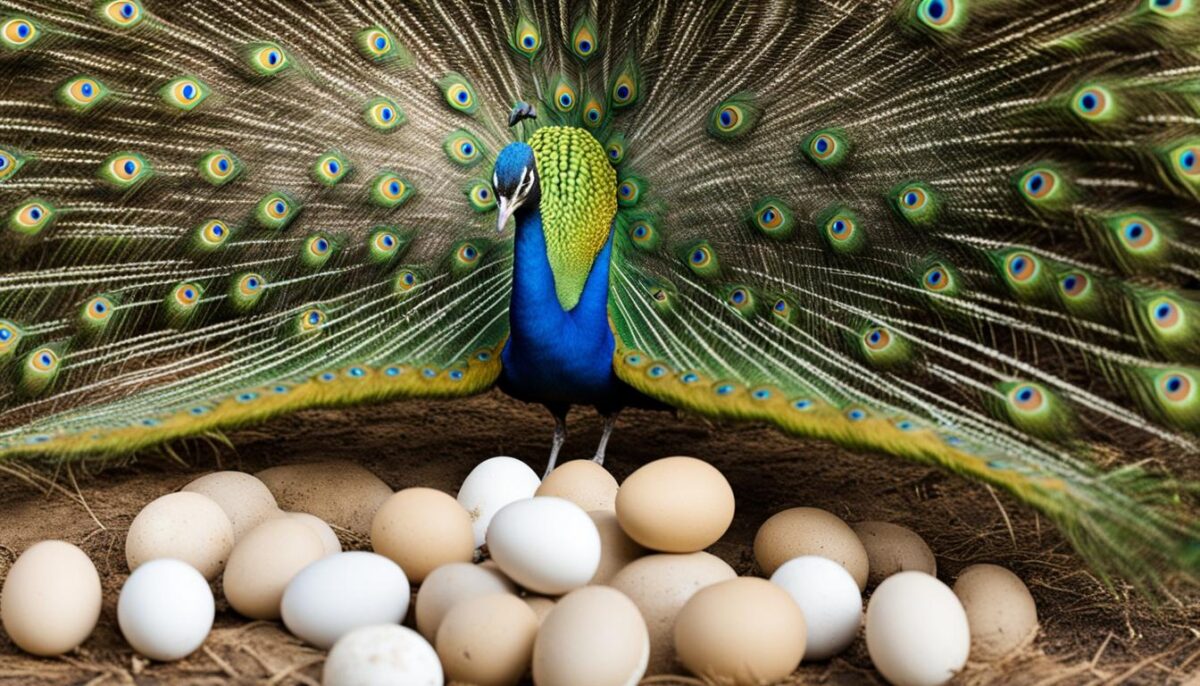
Train Feathers and Molting
After the breeding season, the male peacock sheds its train feathers in a process called molting. This shedding allows the peacock to regrow new feathers that are fresh and vibrant. The molting process is essential for the health and aesthetics of the male peacock’s plumage.
It is important to note that peafowl go through a series of molts before reaching their full maturity and developing their iconic train feathers. Usually, it takes around two years for a peacock to reach its full adult plumage.
Summary
In summary, the lifecycle of peacocks involves a mating season where male peacocks display their train feathers to attract females. After mating, the male peacock goes through a molting process to shed old feathers and grow new ones. This cycle continues until the peacock reaches its full maturity and develops its majestic plumage.
The Care and Breeding of Peacocks
Proper care and attention are essential for the well-being of peacocks. Whether you have a single peacock or a flock of peafowl, understanding their needs is crucial for their health and happiness.
Caring for Peahen Nests
Peahens, the female peacocks, build their nests on the ground to lay their eggs. These nests should be situated in a quiet and secluded area, away from disturbances. It is important to provide nesting materials such as straw or hay to ensure a comfortable and safe environment for the peahens.
“Peahens carefully choose the nesting site for its security and protection. Providing them with proper nesting materials will encourage nest-building behavior.”
Peafowl Diet and Nutrition
Peafowl require a balanced and nutritious diet to thrive. Their diet should consist of a combination of protein-rich foods and grains. Commercially available peafowl feeds, chick crumb, and game bird starter are excellent options. You can also supplement their diet with fruits, vegetables, and insects as occasional treats.
“It is important to provide a well-rounded diet for peafowl to ensure their nutritional needs are met. A balanced diet promotes their overall health and enhances their feather quality.”
Raising Peachicks
Raising peachicks can be a rewarding but delicate task. Peachicks require a warm and secure brooding area during their early stages. The brooding area should be kept at a temperature between 95-100°F (35-38°C) for the first few weeks. Provide a clean and spacious enclosure that is well-ventilated and protected from predators.
“When raising peachicks, it is important to ensure they have access to clean water, suitable feed, and a safe environment. Regular monitoring and attention to their needs will help them grow into healthy adults.”
| Peafowl Care Tips | Peafowl Breeding Tips |
|---|---|
|
|
By following these care and breeding tips, you can ensure the well-being and successful reproduction of your peafowl. Remember, peacocks require attention, patience, and a nurturing environment to thrive and reveal their stunning beauty.
The Behavioral Characteristics of Peacocks
Peacocks are captivating creatures known for their distinctive behaviors and displays. Understanding these behavioral characteristics provides valuable insight into their intriguing nature.
Train Rattling
One of the most mesmerizing behaviors of peacocks is their train rattling display. The male peacock, or peafowl, fans out its long, iridescent tail feathers into a magnificent display of vibrant colors and intricate patterns. This mesmerizing spectacle is intended to attract the attention of the female peahens during mating season. The train rattling display is a captivating sight and a testament to the beauty and grandeur of these birds.
Vocalizations
Peacocks are not just visually stunning, but they also possess a unique vocal repertoire. During the mating season, male peacocks emit a series of distinctive calls and vocalizations to signify their presence and attract potential mates. These vocalizations can range from deep, resonant calls to high-pitched screams. The combination of their stunning visual displays and enchanting vocalizations makes peacocks a truly remarkable species.
Social Interactions
Peacocks are not solitary birds and often engage in social interactions within their flocks. They form hierarchical structures, with dominant males establishing territories and asserting their presence through displays of their vibrant feathers. Peacocks also engage in courtship rituals and engage in aggressive behaviors towards competing males. These social interactions contribute to the dynamic and fascinating nature of peacock behavior.
| Behavioral Characteristic | Description |
|---|---|
| Train Rattling | Display of vibrant tail feathers to attract mates |
| Vocalizations | Unique calls and vocalizations during mating season |
| Social Interactions | Hierarchical structures and courtship rituals |
The Symbolism and Cultural Significance of Peacocks
Peacocks have long held symbolism and cultural significance in various traditions and religions around the world. One of the notable associations is found in the Hindu religion, where peacocks are considered sacred and associated with gods and goddesses. In Hindu mythology, the peacock is believed to be the vehicle of Lord Murugan, the God of War and Victory. Its vibrant feathers and majestic presence are seen as representations of the divine qualities of beauty, grace, and protection.
In Greek mythology, the peacock is linked to the goddess Hera. According to the myth, Argus, a hundred-eyed giant, was assigned by Hera to guard the maiden Io. When Argus was slain by the god Hermes, Hera took his eyes and placed them on the peacock’s tail as a symbol of eternal vigilance and protection. The peacock thus became a symbol of immortality and watchfulness.
“The peacock is a creature of the gods, and its beauty is a constant reminder of the divine presence in our lives.”
Throughout history, peacocks have been depicted in various forms of art and literature. Their striking plumage has captivated artists and poets alike, inspiring beautiful artistic depictions. Ancient civilizations, such as those in Mesopotamia and Egypt, portrayed the peacock in their artworks, symbolizing royalty, immortality, and resurrection. In Renaissance art, peacocks were often depicted as symbols of vanity and pride.
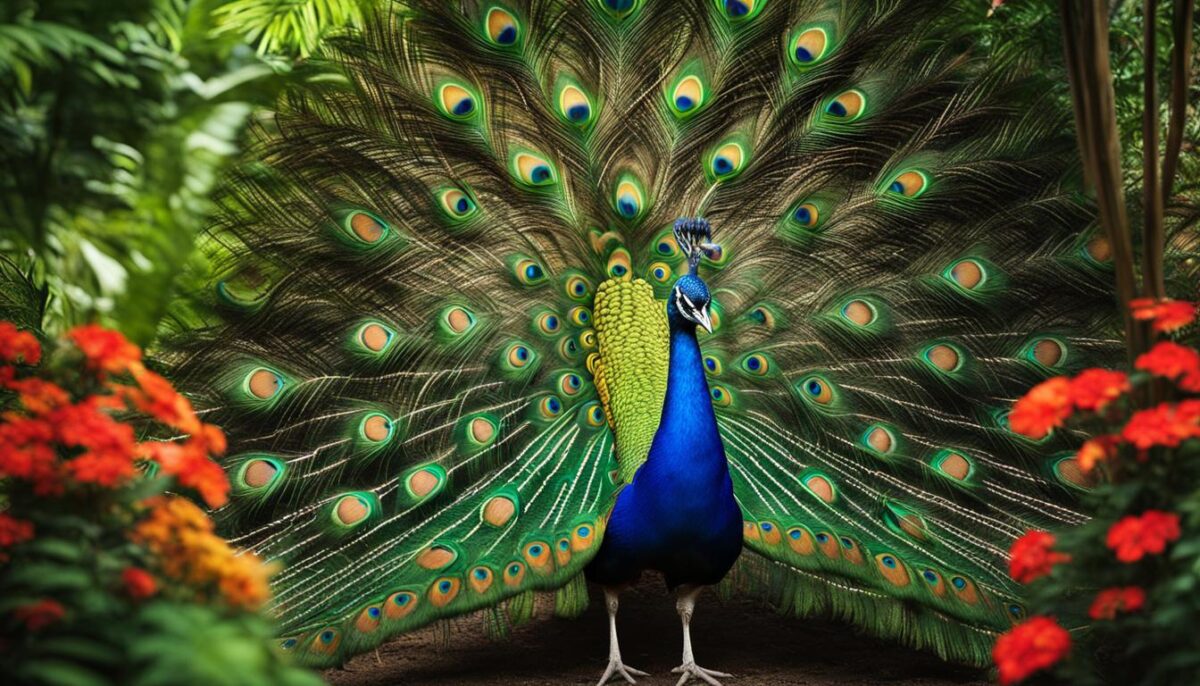
Today, the symbolism of peacocks continues to resonate in modern culture. The peacock’s association with beauty, grace, and divinity has made it a popular motif in fashion, home decor, and jewelry. Its vibrant colors and regal presence make it a captivating subject for artistic inspiration and creative expression. The peacock’s cultural significance serves as a reminder of the interconnectedness of nature, spirituality, and human culture.
The Historical Uses of Peacocks
Peacocks have a fascinating history of being utilized for their meat and served as a luxury dish in various cultures. In medieval times, these majestic birds were highly prized and often featured prominently in extravagant feasts and banquets.
“The peacock, in all its splendor, was the centerpiece of medieval feasts, symbolizing opulence and prosperity. Served as a delicacy, peacock meat was considered a true luxury reserved for special occasions.”
The preparation of peacocks for consumption was a complex process that involved intricate cooking techniques and elaborate presentation. The meat was often roasted or braised and seasoned with a variety of flavorful herbs and spices. It was then garnished with vibrant and colorful fruits and vegetables to create an exquisite visual display on the dining table.
These indulgent displays of peacock meat showcased the wealth and status of the host, as well as their ability to procure such rare and exotic ingredients. The sight of a beautifully roasted peacock adorned with its stunning plumage would leave guests in awe and admiration.
| Peacock Meat Dishes | Description |
|---|---|
| Peacock Pie | A savory pie made with a combination of peacock meat, herbs, and spices. |
| Roasted Peacock | A whole peacock that is carefully roasted to perfection, resulting in tender and flavorful meat. |
| Peacock Stew | A rich and hearty stew made with peacock meat, vegetables, and aromatic seasonings. |
While the consumption of peacock meat may no longer be as prevalent today, its historical significance in culinary traditions continues to intrigue and captivate. The extravagant feasts where peacock meat was served are a testament to the allure and grandeur associated with these beautiful birds.
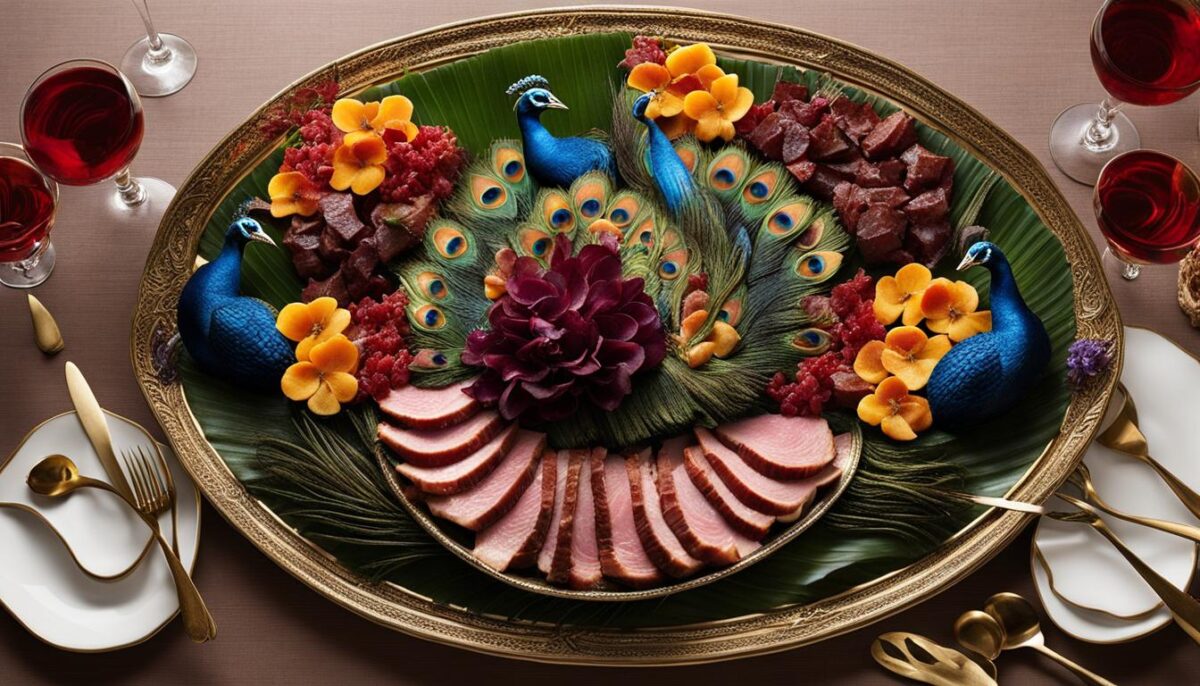
Key Takeaways:
- Peacocks have been historically used for their meat and served as a luxury dish.
- During medieval feasts, peacock meat symbolized opulence and prosperity.
- Peacock meat was prepared using elaborate cooking techniques and garnished for exquisite presentations.
- Popular peacock meat dishes included peacock pie, roasted peacock, and peacock stew.
- While the consumption of peacock meat has diminished over time, its historical significance remains.
The Crests and Other Unique Features of Peacocks
Peacocks are renowned for their stunning beauty and unique features. One of the most striking characteristics of peacocks is their crests. Both male and female peacocks have long feathers on their heads that form elaborate crests. These crests play a significant role in the peafowls’ display behaviors, particularly during courtship.
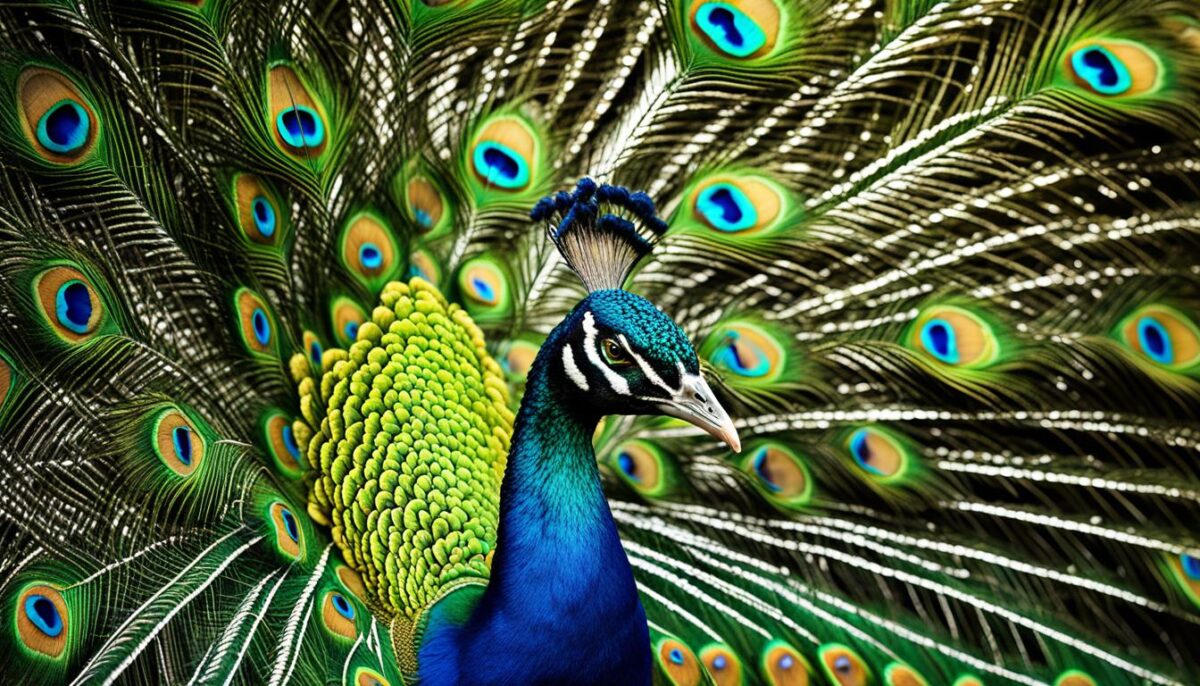
The crests of peacocks are sensory organs, equipped with specialized cells that can detect changes in air pressure, temperature, and humidity. These feathers not only enhance the peacock’s appearance but also serve a functional purpose. When a peacock feels threatened or senses danger, it can raise its crest, making itself appear larger and more intimidating to potential predators.
In addition to their crests, peacocks are also known for their magnificent tail feathers. The vibrant and iridescent colors of a peacock’s tail feathers are truly captivating. During courtship displays, the peacock fans out its tail feathers in an impressive spectacle referred to as a “train display.” This display is meant to attract the attention of peahens and assert dominance among rival males.
Despite their long and heavy feathers, peacocks are capable of short flights. While they are not strong fliers, their wings enable them to navigate their surroundings and reach suitable nesting locations. These flight capabilities are essential for peacocks to escape from predators and find safe spaces for breeding and raising their young.
The Popularity and Conservation of Peacocks
Peacocks hold a significant place in both the natural world and human culture. In India, they have been designated as the national bird, highlighting their importance and cultural significance. Peacocks are deeply woven into the fabric of Indian society, appearing in art, literature, and religious rituals. Their vibrant plumage and graceful presence captivate people around the world, making them a popular bird species for bird enthusiasts and nature lovers alike.
While peacocks are admired for their beauty, their conservation is also a matter of great importance. Efforts are being made to protect peafowl populations and preserve their natural habitats. Conservation initiatives focus on maintaining biodiversity and ensuring the survival of these magnificent creatures for future generations.
“The peacock is a symbol of grace, beauty, and spirituality in Indian culture. It represents the harmonious coexistence of nature and humanity.”
– Dr. Rajendra Singh, Environmentalist
Conservation efforts involve various strategies, including wildlife management, habitat restoration, and public awareness campaigns. By raising awareness about the importance of peacock conservation, we can instill a sense of responsibility in individuals and communities to protect these majestic birds and their habitats.
The Impact of Peacock Conservation
Conservation efforts for peacocks have far-reaching effects beyond the preservation of a single species. Protecting peafowl populations helps maintain the balance of ecosystems, as these birds play a crucial role in seed dispersal and insect control. Furthermore, the success of peacock conservation efforts serves as an indicator of the overall health of the environment and the effectiveness of conservation initiatives as a whole.
| Benefits of Peacock Conservation | Challenges and Solutions |
|---|---|
|
|
Peacock conservation is a collaborative effort involving governments, environmental organizations, and local communities. By working together, we can ensure the continued existence of these iconic birds and protect the ecosystems they inhabit.
The Unique Characteristics of Chickens
Chickens are fascinating birds that have become popular in the world of backyard farming. They possess unique characteristics that make them suitable for poultry raising and provide various benefits to farmers and enthusiasts alike. Understanding these characteristics is essential for successful chicken care and ensuring optimal productivity.
One important aspect of chicken care is providing proper housing, such as bird coops. These coops not only provide shelter and protection for the chickens but also help in maintaining a clean and organized environment. Chicken coops should be spacious enough to allow free movement, with adequate ventilation to prevent the buildup of moisture and harmful gases. Additionally, nesting boxes should be provided to encourage egg-laying and ensure the comfort of the chickens.
Another crucial factor in chicken care is their diet. Chickens have specific dietary needs and require a well-balanced, nutritious bird feed. The feed should contain essential nutrients such as protein, carbohydrates, vitamins, and minerals to support their growth, egg production, and overall health. It is important to provide a consistent and high-quality feed to ensure optimal nutrition for the chickens.
| Chicken Characteristics | Description |
|---|---|
| Good Egg Layers | Chickens are known for their ability to lay eggs, making them a valuable asset for egg production in backyard farms. |
| Various Breeds | Chickens come in different breeds, each with its own unique characteristics and purposes, such as meat production or ornamental value. |
| Adaptability | Chickens are adaptable to different climates and can thrive in various environments, making them suitable for backyard farming in diverse regions. |
| Social Creatures | Chickens are social animals and prefer to live in flocks. They establish hierarchies within their groups and exhibit communal behavior. |
Chickens are not only fascinating creatures but also valuable contributors to backyard farming. Their unique characteristics, proper housing, and nutritious diets are key factors in successful poultry raising. Whether for egg production or as beloved pets, chickens have earned their place in the hearts and backyards of many enthusiasts.
Conclusion
Peacocks and chickens are truly captivating birds that deserve our attention and care. By understanding their unique characteristics, behaviors, and needs, we can contribute to the protection of biodiversity and the conservation of their natural habitats.
Preserving the rich diversity of peacock breeds, such as the Indian Blue, Java Green, and Congo Peafowl, is crucial for maintaining the beauty and variety within these species. Similarly, ensuring the well-being of backyard chickens and their various breeds is important for sustaining poultry farming practices.
Conservation efforts play a vital role in safeguarding the populations of peacocks and chickens. Protecting their habitats, educating bird enthusiasts and farmers about responsible care practices, and supporting initiatives that promote biodiversity are all essential in preserving these magnificent birds for future generations.
Let’s Protect and Preserve
Peacocks and chickens are not only fascinating creatures but also integral parts of our ecosystems. By valuing their presence and taking active steps to protect them, we can contribute to the overall health and balance of our environment. Let us appreciate the beauty of peacocks and the usefulness of chickens while working towards a sustainable future for all species.
FAQ
What are the different breeds of peacocks?
The different breeds of peacocks include the Indian Blue, Java Green, and Congo Peafowl.
What is the most well-known breed of peacock?
The Indian Blue is the most well-known breed of peacock.
Are Java Greens endangered?
Yes, Java Greens are considered an endangered species.
What do Congo Peafowl look like?
Congo Peafowl are smaller in size and resemble pheasants.
How long does it take for a peacock to reach full maturity?
It takes about two years for a peacock to reach full maturity and develop its vibrant plumage.
How do peahens lay their eggs?
Peahens build nests on the ground to lay their eggs.
What do peafowl eat?
Peafowl need a diet high in protein and can eat a variety of foods, including chick crumb and dog or cat food.
How often do peahens lay eggs?
If the eggs are removed, peahens will lay another clutch a few months later.
What unique behaviors do peacocks exhibit?
Peacocks exhibit unique behaviors such as train rattling and vocalizations during the mating season.
What is the symbolism of peacocks in Hinduism?
Peacocks are associated with gods and goddesses and are considered sacred in the Hindu religion.
What historical uses did peacocks have?
Peacocks were used for their meat and were considered a luxury dish, often served at medieval feasts as a sign of wealth and status.
What are the unique features of peacocks?
Peacocks have crests that serve as sensors and remarkable tail feathers used in displays and mating rituals. They are also capable of short flights.
What is the cultural importance of peacocks in India?
Peacocks are the national bird of India and hold cultural significance in art, literature, and religious rituals.
What are some unique characteristics of chickens?
Chickens are popular in backyard farming and are known for their ability to lay eggs. They require proper housing and specific dietary needs.
Why is understanding the needs and behaviors of peacocks and chickens important?
Understanding their needs and behaviors is essential for their conservation and habitat protection, contributing to the preservation of biodiversity and the natural world.


